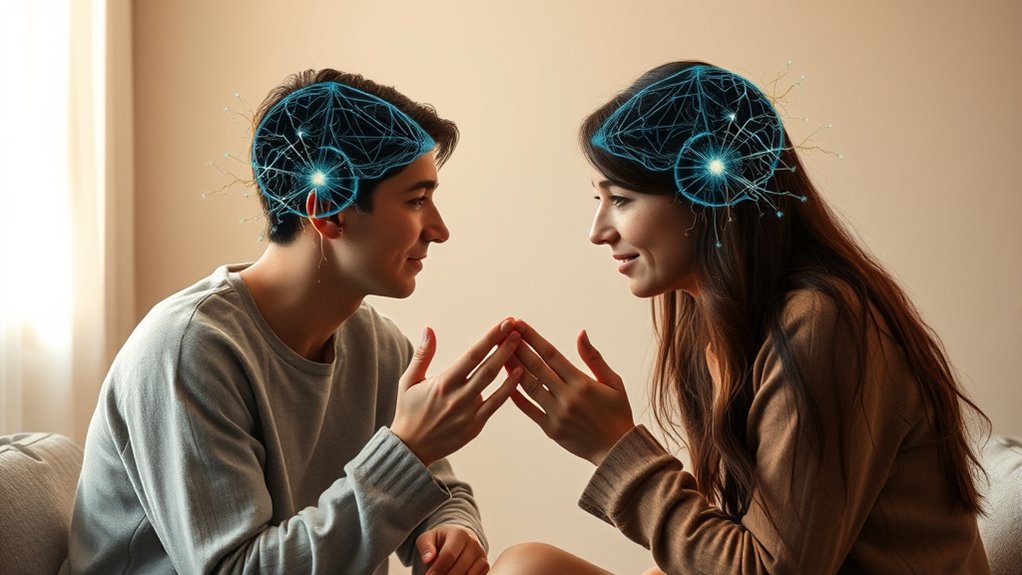Mirror neurons play a key role in empathy by allowing you to internally simulate others’ actions and emotions. When you observe someone feeling happy or sad, these neurons activate, creating a shared experience and fostering emotional resonance. This neural mirroring helps you understand and connect with others better, shaping social bonds and compassion. If you want to explore how these neurons develop and influence your social skills, there’s much more to uncover below.
Key Takeaways
- Mirror neurons activate during observation of others’ actions or emotions, enabling internal simulation and understanding of their feelings.
- They facilitate emotional resonance by mirroring observed expressions, fostering shared emotional experiences.
- Activation patterns in mirror neuron systems form the neural basis for empathy and social bonding.
- Neural plasticity strengthens mirror neuron pathways through social interactions, enhancing empathetic responses over time.
- Dysfunction or deficits in mirror neuron activity are linked to impaired empathy, as seen in conditions like autism spectrum disorder.
How Mirror Neurons Discover Empathy

Mirror neurons, a special type of brain cell, play an essential role in how we comprehend and share others’ emotions. They facilitate sensorimotor integration by activating when you observe someone performing an action or expressing an emotion, allowing you to internally simulate their experience. This process helps you understand their feelings more deeply. As you repeatedly experience these shared actions, neural plasticity shapes and strengthens the connections between mirror neurons, enhancing your ability to empathize over time. This adaptability means your brain becomes more efficient at recognizing and resonating with others’ emotional states. By linking sensory input with motor responses, mirror neurons serve as the foundation for developing empathy through continuous interaction and learning. Additionally, engaging in sensitive social interactions can further strengthen these neural pathways, improving empathetic responses. Moreover, research indicates that neural plasticity allows the brain to adapt and refine these processes with experience. Understanding how these mechanisms work highlights the importance of emotional intelligence in fostering meaningful connections. Furthermore, insights from neuroscience research suggest that targeted activities can actively enhance empathy by stimulating mirror neuron activity.
The Neural Basis of Shared Experiences

You can see how mirror neuron activation patterns create a shared sense of experience by mirroring others’ actions and emotions. Emotional resonance mechanisms allow you to feel a connection when observing someone else’s feelings. Observational learning processes help you learn behaviors and social cues through watching others, strengthening shared understanding. Additionally, social interaction dynamics can facilitate visual cues that enhance social interactions within shared spaces. These processes are supported by the brain’s ability to enhance cognitive function through such shared experiences, promoting better social cohesion and empathy development. Studies show that regions like the inferior frontal gyrus are actively involved in these mirroring processes, further reinforcing the neural basis of empathy.
Mirror Neuron Activation Patterns
When observing someone perform an action or express an emotion, specific neurons in your brain activate in patterns that mirror their behavior, forming the neural basis of shared experiences. These activation patterns involve sensorimotor integration, where sensory input and motor responses work together to simulate what you see. Cortical mirroring is crucial here, as certain areas in your brain’s cortex fire in a way that replicates the observed behavior. This neural activity allows you to understand and resonate with others’ actions and feelings, creating a shared neural footprint. Your mirror neuron system fundamentally translates observed movements into internal representations, enabling you to vicariously experience what others are doing or feeling. This precise activation pattern underpins the foundation of empathy and social connection. Additionally, brain plasticity plays a role in strengthening these neural pathways over time, enhancing empathetic abilities through shared experiences, thereby facilitating neural adaptation that supports ongoing social understanding. Moreover, understanding the neural mechanisms involved in empathy can help develop targeted interventions for social cognitive deficits. Recognizing how credit card insights influence financial behaviors can also deepen your understanding of social interactions and trust.
Emotional Resonance Mechanisms
Emotional resonance mechanisms form the neural foundation that allows you to share and feel each other’s emotions deeply. When someone nearby expresses happiness or sadness, emotional contagion kicks in, causing your brain to mirror those feelings. This process results in affective synchronization, aligning your emotional states with theirs. Your mirror neuron system detects and responds to observed emotions, fostering an automatic, subconscious connection. This neural response helps you experience others’ feelings as if they were your own, strengthening social bonds. Such mechanisms enable empathy to operate not just through understanding but through genuine emotional sharing. By naturally syncing with others’ emotional states, you build trust and social cohesion, essential for meaningful relationships and social interactions. Additionally, the mirror neuron system plays a critical role in translating observed actions into shared emotional experiences, further enhancing empathy and social understanding. Recognizing how these neural mechanisms facilitate emotional sharing highlights their importance in social cohesion and emotional intelligence. Furthermore, ongoing research continues to uncover how emotional contagion influences group dynamics and collective emotional states. For instance, understanding the neurobiological basis of these processes can help improve social skills and emotional regulation.
Observational Learning Processes
Observational learning processes rely on the brain’s ability to encode and replicate actions and experiences observed in others. Mirror neuron evolution shows how these neurons developed to facilitate imitation and understanding across species. When you watch someone perform an action, your mirror neurons activate similarly to if you were doing it yourself, enabling you to learn without direct experience. Cross-species comparisons reveal that many animals, including primates and birds, share this neural mechanism, highlighting its evolutionary importance. This shared capacity allows you to acquire new skills, interpret social cues, and build empathy through observation. The neural basis of these processes underscores how shared experiences are grounded in the brain’s ability to mirror others’ actions, fostering both learning and social cohesion. Additionally, research indicates that neural plasticity plays a crucial role in strengthening these mirror neuron networks over time, enhancing your capacity for empathy and social understanding. Moreover, neuroplasticity can be influenced by experience, suggesting that engaging in social interactions may further develop these neural networks.
Mirror Neurons and Emotional Resonance

Mirror neurons play a crucial role in fostering emotional resonance, allowing you to instinctively feel what others are experiencing. Their mirror neuron specificity means they respond selectively to certain emotional cues, such as facial expressions or tone of voice. When you see someone smile or express sadness, these neurons activate in your brain, creating a sense of emotional contagion. This process helps you connect deeply with others’ feelings without conscious effort. By mirroring their emotional states, you naturally experience empathy on a visceral level. This automatic resonance builds trust and understanding, making social interactions more meaningful. Fundamentally, mirror neurons serve as the neural foundation for emotional resonance, enabling you to share and understand others’ feelings through direct, subconscious simulation. Additionally, understanding how emotional cues activate mirror neurons can enhance your ability to empathize effectively in social situations. Recognizing the importance of spiritual energy in these processes can further deepen your empathetic connections.
The Connection Between Observation and Response

When you observe others, your mirror neurons activate, prompting you to mimic their actions and emotions. This neural response strengthens emotional resonance and helps you understand what others feel. Through this process, you learn and respond more effectively by simply watching and connecting.
Mimicry and Neural Activation
Mimicry plays a essential role in how your brain connects observation to response through neural activation. When you observe someone perform an action, your mirror neuron system engages, facilitating sensorimotor integration that links perception to potential responses. This process allows you to simulate the action internally, effectively translating visual cues into motor commands. Action perception is critical here, as it triggers specific neural pathways associated with the observed movement. By mirroring the actions you see, your brain prepares appropriate responses, creating a seamless link between seeing and doing. This mimicry-driven neural activation underpins social interactions and empathy, enabling you to intuitively understand others’ intentions and feelings through their actions. It’s a fundamental mechanism that bridges observation and behavioral response.
Emotional Resonance Mechanisms
Observing others’ emotions activates specialized neural circuits that link perception directly to your emotional responses. This process, known as emotional resonance, involves sensorimotor integration, where your brain translates observed actions into internal feelings. Neural connectivity between visual, motor, and emotional centers facilitates this link, allowing you to feel others’ experiences intuitively. Here’s a simplified view:
| Observation | Neural Response | Emotional Response |
|---|---|---|
| Smiling face | Mirror neuron activation | Happiness |
| Angry gesture | Sensorimotor coupling | Empathy or concern |
| Sad expression | Emotional resonance pathways | Compassion |
This seamless integration helps you respond authentically, fostering empathy through a rapid, automatic connection between observation and feeling. Your brain’s neural connectivity ensures these responses are quick and genuine, deepening your emotional understanding.
Learning Through Observation
Learning through observation occurs when your brain directly links what you see to your future actions and responses. Mirror neuron diversity means that different individuals may activate these neurons differently, affecting how effectively you learn by watching others. Cultural influences also shape how you interpret and imitate behaviors, as your environment teaches you which responses are appropriate. When you observe someone demonstrating a skill or emotion, your mirror neurons fire as if you were experiencing it yourself. This neural mirroring helps you internalize behaviors and develop responses aligned with your social context. Over time, repeated observation strengthens these connections, making responses more automatic. By understanding this process, you recognize how your brain constantly learns and adapts through simple acts of watching others.
Evidence From Brain Imaging Studies

Brain imaging studies provide compelling evidence that mirror neuron systems are closely linked to empathy. Using advanced brain imaging techniques like fMRI and PET scans, researchers observe activation in specific brain areas when individuals experience empathy or observe others’ emotions. These studies reveal mirror neuron specificity, showing that similar regions activate whether you feel or see someone else feeling an emotion. For example, when you watch someone express pain, your brain activates regions involved in processing pain, highlighting the mirror system’s role. This consistent activation pattern supports the idea that mirror neurons help understand others’ feelings by simulating their emotional states internally. Overall, brain imaging studies solidify the connection between mirror neuron activity and empathetic responses, emphasizing their essential role in social cognition.
Developmental Aspects of Empathy and Mirror Cells

| Stage | Key Features | Influencing Factors |
|---|---|---|
| Infancy | Basic imitation skills | Caregiver interactions |
| Early childhood | Recognizing emotions | Play and social learning |
| Adolescence | Empathy refinement | Peer relationships |
| Adulthood | Mature empathetic responses | Continued social experiences |
Implications for Social Interaction and Understanding

Have you ever wondered how understanding others’ emotions shapes your social interactions? Mirror neurons play a key role in this process, influencing how you connect and communicate. Cultural influences affect how empathy is expressed and interpreted, shaping your social responses. Language development benefits from mirror neuron activity, enabling you to better grasp emotional nuances through conversation. Consider these points:
- They enhance your ability to read social cues.
- They help you share emotional experiences.
- They facilitate learning social norms.
- They improve cross-cultural understanding.
Mirror Neurons and Autistic Spectrum Disorders

You might notice that some individuals with autism have differences in how their mirror neuron systems function. These dysfunctions could contribute to challenges with social cues and empathy. Researchers are exploring therapeutic interventions aimed at improving mirror neuron activity to support social development.
Mirror Neurons Dysfunction
Research suggests that dysfunction in mirror neuron systems may contribute to some social and empathetic challenges observed in individuals with autism spectrum disorders (ASD). When mirror neurons don’t function properly, you may experience empathy deficits, making it harder to relate to others. Here’s what this means:
- Reduced ability to understand others’ emotions.
- Difficulty imitating or mirroring social cues.
- Challenges in recognizing facial expressions.
- Limited emotional resonance during social interactions.
This mirror neurons dysfunction can impair your capacity for spontaneous empathy, affecting social bonding and communication. The connection between mirror neuron activity and empathy deficits highlights how neural mechanisms influence social behavior, especially in ASD. Understanding this helps clarify why some individuals struggle with social reciprocity.
Therapeutic Interventions
Therapeutic interventions targeting mirror neuron dysfunction aim to improve social and empathetic skills in individuals with autism spectrum disorders. Researchers explore various approaches considering mirror neuron diversity and insights from cross species comparison. These strategies include imitation training, social skills therapy, and neurofeedback, designed to activate mirror neuron circuits. Understanding how different species share similar neural mechanisms helps refine interventions and tailor them to individual needs. The table below summarizes some common therapies:
| Therapy Type | Focus |
|---|---|
| Imitation Training | Enhances mirror neuron activity through mimicry |
| Social Skills Therapy | Builds empathy via interactive exercises |
| Neurofeedback | Regulates neural activity related to empathy |
| Animal-Assisted Therapy | Leverages cross species comparison for engagement |
Enhancing Empathy Through Neural Plasticity

Neural plasticity—the brain’s ability to reorganize itself—plays a crucial role in enhancing empathy. Through this flexibility, your brain can strengthen or develop mirror neuron networks, influenced by ongoing experiences. Key ways to harness this include:
- Engaging in diverse social interactions to promote mirror neuron evolution
- Practicing empathy exercises that activate neural pathways
- Studying cross species studies to understand shared empathy mechanisms
- Participating in targeted training programs that reinforce social understanding
Future Directions in Mirror Neuron Research

As technology advances, exploring the future of mirror neuron research promises to open deeper insights into human empathy and social cognition. You’ll see researchers examining how genetic influences shape mirror neuron activity, shedding light on individual differences in empathetic responses. Additionally, understanding cultural variations will be pivotal, as different societies may develop distinct neural patterns related to empathy and social understanding. Future studies might combine neuroimaging with genetic analysis to identify specific genes involved in mirror neuron functioning. By exploring these areas, you’ll gain a clearer picture of how innate biology and cultural context interact to influence empathy. This integrated approach could lead to personalized interventions for social deficits and enhance cross-cultural understanding, ultimately expanding our grasp of the neural basis for human social behavior.
Frequently Asked Questions
How Do Mirror Neurons Develop in Early Childhood?
During early childhood, your mirror neurons develop through sensorimotor development and social imitation. As you observe and imitate others’ actions, these neurons strengthen, helping you understand and mimic emotions and behaviors. Repetitive interactions with caregivers and peers enhance this process, making it easier for you to connect socially. This development is vital for empathy, as it enables you to intuitively grasp others’ feelings by mirroring their actions and expressions.
Can Mirror Neuron Activity Be Intentionally Stimulated or Enhanced?
You can intentionally stimulate or enhance mirror neuron activity through brain stimulation techniques like transcranial magnetic stimulation (TMS) or by engaging in empathy training exercises. These methods help activate regions involved in social understanding, boosting empathy. By practicing activities that involve observing others’ emotions, you strengthen your mirror neuron system, improving your ability to empathize and connect with others more deeply.
Are There Differences in Mirror Neuron Function Across Cultures?
They say “variety is the spice of life,” which highlights how cross-cultural empathy varies through neural diversity. You might notice differences in mirror neuron function across cultures, influenced by social norms and experiences. These variations affect how people understand and connect with others. While the core mechanism remains, your neural responses can adapt, making empathy a dynamic process shaped by cultural context.
How Do Deficits in Mirror Neurons Affect Adult Social Relationships?
When you have empathy deficits, you might struggle to understand or share others’ feelings, which can harm your social relationships. This often leads to social isolation, as people may find it hard to connect with you. Deficits in mirror neurons reduce your ability to mimic and resonate with others’ emotions, making social interactions less meaningful and harder to maintain, ultimately impacting your social support networks and emotional well-being.
What Are the Ethical Considerations in Manipulating Mirror Neuron Activity?
Imagine you’re at a crossroads, deciding whether to alter your brain’s mirror neuron activity. Ethical concerns like consent issues and privacy worries come into play, reminding you that manipulating this system affects how you connect with others. You must consider if you’re comfortable with potential changes to your empathy and social skills, ensuring you’re fully informed and in control before any intervention. Respecting autonomy is key in this delicate balance.
Conclusion
Understanding mirror neurons helps you see how empathy truly works in your brain. Did you know that studies show 60% of people with stronger mirror neuron activity report higher empathy levels? By tapping into these neural pathways, you can better connect with others’ emotions and improve social interactions. Keep exploring this fascinating field, because revealing your mirror neurons could lead to deeper, more meaningful relationships and a greater understanding of those around you.









